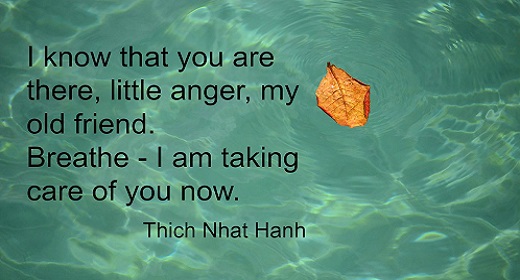by Donna Quesada: Last week I wrote an article on anger, focusing on the disagreeable but popular method of venting as a strategy for anger management…
as recently seen on TV shows like Celebrity Detox. While writing the article, I found myself in the middle of my own domestic uproar. My husband and son have long had a tense relationship and on the night of Christmas, it exploded.
Thankfully, reparations have already begun, but it will take some time to build a truly healthy relationship. As Zen monk and peace activist Thich Nhat Hanh says, learning how to be mindful of our reactions is the unparalleled place to start. In its most basic sense, mindfulness is to pay attention, and when we pay attention, we are no longer merely reacting to life, but are rather, actively choosing an appropriate course of action. Thus, managing anger is more about managing our reactions. When we are mindful, we become aware of the angry feeling before acting on it in destructive ways.
Mindfulness starts with the breath. As Shakti Parwha Kaur Khalsa says in Kundalini Yoga; The Flow of Eternal Power, “the breath has atomic power.” In a more sane example of television, if you’ve ever seen The Dog Whisperer, you may have noticed Cesar Milan taking a deep breath before approaching an aggressive dog. I wasn’t surprised when I learned about his background in Judo. In unerring synchronicity, the moment we allow anger to get the best of us, our breath becomes erratic and our ability to think clearly is compromised. But worse, as Kaur Khalsa continues, we have then allowed ourselves to become just a “reactive machine, with buttons that anybody can push.”
When we are angry we allow our world to become a living hell. But it doesn’t have to be that way. If we can merely take a few deep, long breaths, we can step into that gap where other possibilities emerge. And after a while, those gaps get bigger. If only we could reside there–in that place where we’re liberated from those reactions, which seem to us at the moment, inevitable. In that place there is a separation between the feeling of anger and our reaction. That place is the difference between heaven and hell.
It seems deceptively simple, but how many people actually sit down and do yogic breathing at the first sign of agitation? Besides, simple doesn’t always mean easy. It takes commitment and willful application. My husband confessed honestly that in the context of that dispute with our son, he hadn’t stopped to just take a breath. Among other tools, he has since learned sitali pranayam, the calming breath which curtails the irritation before it escalates. Simply breathing is like flipping the fan switch on a hot day – the welcome cooling effect is immediate.
One of my own teachers, Guru Singh, explains the physiological shift that occurs when we bring our attention to the breath: “you ground your body with your brain and then with your environment.” It is the simplest of the ‘mindfulness meditation’ forms, he says. “It increases the brain’s connection to each present moment by causing the production of electrochemical charges,” which in turn, “connect the sensory system to the nervous system to the glands and organs, back to the nervous system and onto the brain, producing sensations, thoughts, calculations, and then attitudes of calm.”
The alternative is unfortunately, the stressful state that so many accept as normal–state in which we simply react to the random whims and thoughts buzzing through our heads. And in that state of chaos the usual response is to look for temporary relief in the form of more destructive habits, like drugs and alcohol, that only provide a temporary numbing effect. The saddest part of that common scenario is that we never find sanctuary inside ourselves.
Alongside mindfulness, are the many other essential tools of yoga. When mindful attention through the mechanism of the breath is spontaneous, when it becomes more natural than lashing out, Kaur Khalsa suggests we direct our concentration to our higher chakras, where we can access “the neutral mind,” and convert that fire into more constructive and courageous forms of energy–a process that might be likened to water and the myriad ways it can be converted into different forms with different capacities.
And lest we forget the obvious, we may also decide to physically remove ourselves from the situation, the person, or whatever it is that is causing our anger. We can learn to remove ourselves psychologically, as well. We won’t necessarily stop the mental noise altogether, but through the various forms of meditation that yoga offers, we can learn to transform the negative thoughts into healthier ones. This action allows us to remove ourselves from the spinning wheel of suffering. Removing ourselves in either of these ways are examples of restraint. Both exemplify ahimsa–nonviolence–the fundamental starting point of the yogic path.
Going further up the limbs of yoga, we can find refuge in the practice of pratyahar–resisting the bombardment of our senses, the drama, staying steady in the midst of commotion–knowing that it is the mind, after all, that dictates whether something is annoying or not.
Finally, may we all remember how the Dalai Lama answered, when asked who is his greatest teacher. Mao, he said…because those who anger us reveal our shortcomings, and allow us to grow.
—
“By effort and heedfulness, discipline and self-mastery, let the wise one make for himself an island which no flood can overwhelm.” ~Buddha









































